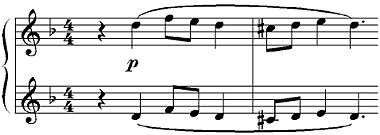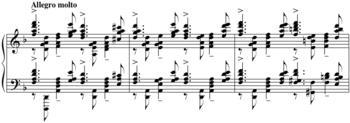Piano Concerto No. 3 (Rachmaninoff)

The Piano Concerto No. 3 in D minor, Op. 30 by Sergei Rachmaninoff (colloquially known as the "Rach 3") is famous for its technical and musical demands on the performer. It has the reputation of being one of the most difficult concertos in the standard piano repertoire.
Contents |
Form
Following the form of a standard concerto, the piece is in three movements:
- Allegro ma non tanto (D minor)
- The first movement revolves around a diatonic melody that soon develops into complex pianistic figuration. It reaches a number of ferocious climaxes, especially in the cadenza. The first theme in its full form reappears just before the coda. Rachmaninoff wrote two versions of this cadenza: the dramatic and powerful original, commonly notated as the ossia, and a second one with a lighter, toccata-like style. In his recording of the concerto, the composer used the second cadenza.
- Intermezzo: Adagio (F sharp minor/D flat major)
- The second movement is opened by the orchestra and it consists of a number of variations around a single lush, heavily romantic melody following one another without a rigid scheme. The melody soon transitions to a tonic major which is the second theme. After the first theme development and recapitulation of the second theme, the main melody from the first movement reappears, before the movement is "closed" by the orchestra in a manner similar to the introduction. Then the piano gets the last word in with a short "cadenza-esque" passage which transitions into the last movement without pause. Many melodic thoughts of this movement allude to Rachmaninoff's second piano concerto, third movement, noticeably the Russian-like, E-flat major melody.
- Finale: Alla breve (D minor → D major)
- The third movement is quick and vigorous and contains variations on many of the themes that are used in the first movement, which unites the whole concerto cyclically. However, after the first and second themes it diverges from the regular sonata-allegro form. There is no conventional development; that segment is replaced by a lengthy digression using the major key of the third movement's first theme, which then leads to the two themes from the first movement. After the digression, the movement recapitulation returns to the original themes, building up to a toccata climax somewhat similar but lighter than the first movement ossia cadenza. The last movement is concluded with a triumphant and passionate second theme melody in D major. The piece ends with the same four-note rhythm – claimed by some to be the composer's musical signature – as the composer's second concerto.
The third movement follows the second without pause. A typical performance of the concerto lasts about forty minutes.
History

Written in the peaceful setting of his family's country estate, Ivanovka, Rachmaninoff completed the concerto on September 23, 1909. Contemporary with this work are his First Piano Sonata and his tone poem The Isle of the Dead.
The concerto is respected, even feared, by most pianists. Józef Hofmann, the pianist to whom the work is dedicated, never publicly performed it, saying that it "wasn't for" him. And Gary Graffman lamented he had not learned this concerto as a student, when he was "still too young to know fear".[1]
Due to time constraints, Rachmaninoff could not practice the piece while in Russia. Instead, he practiced it on a silent keyboard that he took with him on the ship to the US.
The concerto was first performed on November 28, 1909 by Rachmaninoff himself with the now-defunct New York Symphony Society with Walter Damrosch conducting, at the New Theater (later rechristened the Century Theater). It received a second performance under Gustav Mahler several weeks later, an 'experience Rachmaninoff treasured' [1]. The manuscript was first published in 1910 by Gutheil. The first performance in England was given by G T Ball (later Sir George Thalben-Ball) at the Royal College of Music in London.
Orchestration
The concerto is scored for 2 flutes, 2 oboes, 2 clarinets, 2 bassoons, 4 horns, 2 trumpets, 3 trombones, tuba, timpani, bass drum, snare drum, cymbals and strings.
Performances and recordings
The first recording of the concerto was made by Vladimir Horowitz accompanied by the London Symphony Orchestra conducted by Albert Coates for the HMV label in 1930. This has been listed by English critic and writer Norman Lebrecht as one of the 100 greatest recordings ever made.[2]
Many other famous pianists have recorded the concerto, including Rachmaninoff himself.
One of the most famous recordings of the piece, known for its speed, is that of Martha Argerich performing live with the Deutsches Symphonie-Orchester Berlin conducted by Riccardo Chailly.
Another highly renowned performance of this work is that of the pianist Vladimir Ashkenazy, with Bernard Haitink conducting the Concertgebouw Orchestra.
According to some critics,[3][4] the most technically astounding Rach 3 ever registered is a live performance by Vladimir Horowitz accompanied by the New York Philharmonic Symphony Orchestra under Sir John Barbirolli, available on an off the air recording made in 1941. It has been reported that after Horowitz performed it for Rachmaninoff, the composer was so impressed that he never played the work again.
Links

References
Further reading
- W.R. Anderson: Rachmaninov and his pianoforte concertos. A brief sketch of the composer and his style. London 1947
- Yasser, Joseph (1969), "The Opening Theme of Rachmaninoff's Third Piano Concerto and its Liturgical Prototype", Musical Quarterly LV: 313-328
External links
- Piano Concerto No. 3: Free scores at the International Music Score Library Project.
- The Rach 3 recordings page
- Rachmaninoff's Works for Piano and Orchestra An analysis of Rachmaninoff's Works for Piano and Orchestra including the Piano Concertos and the Paganini Rhapsody
|
|||||